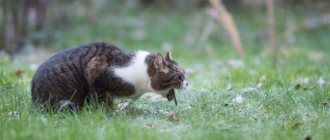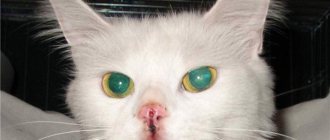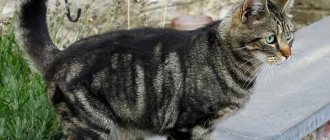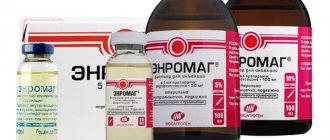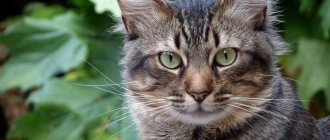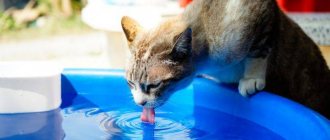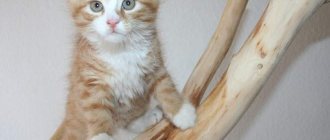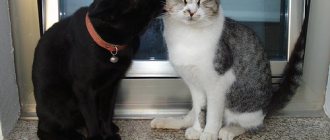Owners of mustachioed pets often encounter damage to furniture. The thing is that at home, a cat’s claws practically do not wear down naturally. Because of this, any available materials are used.
The most drastic way to eliminate the problem is declawing surgery, but such an intervention has many disadvantages. Such an impulsive decision will definitely affect your pet's quality of life, so you should choose safer alternatives instead.
Number of claws
First, let's figure out how many claws a cat has. Despite the number of limbs, there are not 20, but only 18.
How many claws does a cat have on its front paws?
Understanding how many claws a cat has on its front paws is very simple. You need to pick up your pet and carefully examine it. As we explore, it will become clear that at least here we are similar.
At the base of the cat's front foot there are 4 toes, and a little further away there is another additional one, similar to ours, the big one. The claw on this finger makes it easier to grasp objects.
How many claws does a cat have on its hind legs?
You might be surprised to find out how many claws cats have on their hind legs. There are only 4 fingers here. Thus, the total number really is exactly 18.
Help from a veterinarian
The veterinary clinic will help in the most severe cases: when the wound becomes infected and the claw grows deep into the paw. The doctor will conduct an examination. Assess the complexity of the case, the degree of claw ingrowth and the need for surgical intervention.
If the claw is not deeply ingrown and there is no inflammation, the veterinarian will remove the claw using special tools. The wound will be treated with an antiseptic to avoid inflammation. If the wound festers, a decision is made to operate. It is performed under local anesthesia. The place of suppuration is opened, the pus and the ingrown claw are removed. The wound is disinfected.
In severe cases, the operation is performed under general anesthesia. A small incision is made at the site where the claw grows in. The claw is cut off and carefully removed. The accumulated pus is cleaned out. The wound is treated with an antiseptic solution. At the end, a sterile bandage is applied.
Structure of a cat's claw
Cat claws are a specific type of skin, close to the human nail plate. They consist of the epidermis, the outer layer of skin containing large amounts of keratin.
This substance serves to protect soft sensitive tissues hidden in the inner part of the claws - the pulp. It is easy to spot by its pinkish tint. The pulp contains nerve fibers and choroid plexuses, so damage to this area is accompanied by acute pain and bleeding.
It's also worth noting the shape. Most whiskered pets are equipped with sickle-shaped claws, but there are exceptions. For example, the Persians have curved ones. During fights, these cats inflict more dangerous injuries on their opponents, since this shape makes it easier to get right under the skin.
Required Tools
Pet stores offer a wide range of special tools to properly trim your cat's nails.
Nail clippers . These include special pruning shears, reinforced wire cutters, or nail clippers. These are all mechanical tools with a round claw cutout. But they all have one big drawback - the owner who is cutting the claw has difficulty seeing the length of the claw and the place from which it needs to be cut off.
Guillotine trimmer . This is a modern device, easy to use. With its help, the cut is made as rounded as possible. But there is also a drawback here - a working trimmer makes noise, which can frighten an already fearful pet.
Grinder . This is a sharpening stone with an abrasive coating that can be used to painlessly sharpen a claw and polish it.
Regular manicure scissors . But they must be used with caution and only for trimming soft tissues in kittens. This tool is not at all safe for adult cats.
It is important that all these tools are well sharpened and their handles are covered with non-slip material. Before use, the instrument must be treated with a disinfectant.
You will also need an antiseptic to stop the bleeding if a wound forms.
Top 5 Misconceptions About Cats You Believed
Functions of a cat's claws
A cat's claws perform a number of important functions. The most important ones include the following:
- Protective. Whiskered pets use their “edged weapons” for defense against enemies and during hunting, easily tearing apart the soft tissues of caught prey.
- Depreciation. Allows you to land correctly when jumping, maintaining the integrity of your legs and spine even when falling from high floors.
- Communicative. Leaving peculiar marks is a way of marking one’s territory and warning potential rivals.
- Maintaining balance. With the help of additional support, animals can easily move along trees, window sills and various shaky surfaces.
- Muscle relaxation. Clinging to the carpet with its claws, the cat stretches its stiff and overstrained limbs.
- Facilitating the hunting process. The claws retract and extend thanks to tendon ligaments and muscle fibers. A sneaking pet removes them and silently moves towards the victim almost on its toes, without completely stepping on the foot.
The desire to scratch and grind everything around is a completely natural physiological state for all representatives of the cat family. It occurs due to periodic detachment of the stratum corneum as it grows.
Postoperative care
Immediately after removing an ingrown nail, your veterinarian may prescribe antibiotics. They should be taken immediately to avoid the inflammatory process. Additionally, it is recommended to give your pet a complex of minerals and vitamins. In order for injured tissue to quickly recover and heal, immunomodulators are prescribed.
To avoid getting an infection in your foot, wash your floors more often. The room where the pet lives must be clean. Walking and active games are temporarily contraindicated for cats. It is necessary to keep the paw at rest until it has fully recovered.
Why you shouldn't declaw a cat
Onychectomy, or declawing cats, amounts to animal cruelty in several European countries. The thing is that this operation involves partial removal of the phalanx, which is accompanied by difficult long-term rehabilitation and carries very high risks for the person being operated on. The main consequences include the following:
- Formation of abscesses in internal organs. The rupture of these formations is fraught with blood poisoning.
- Acute pain syndrome. After onychectomy, the animal loses its usual activity and appetite, since the wounds take a very long and painful time to heal.
- Fall of immunity. Due to constant stress, the immune response is reduced, leading to more frequent and more severe illnesses.
- Impaired musculoskeletal function. Along with the claws, the former grace is lost, which negatively affects the spine. Also, due to loss of coordination, the number of injuries increases.
- Losing a tool for self-defense. Meeting other animals on a street walk can result in very serious consequences, since the cat has nothing else to protect itself with. If he gets lost, the chances of finding him alive are close to zero.
- There is a high probability of developing osteomyelitis - purulent-necrotic inflammation that destroys bones.
- Heavy bleeding. The animal may die due to excessive blood loss not only during surgery, but during the rehabilitation period.
- Mental change. Loss of a sense of security increases aggression, so the operated pet often attacks its owners. He becomes alienated and withdrawn due to constant fear.
- Regularly relieving yourself in the wrong place. Raking excrement with injured paws causes severe pain, so any cat litter causes severe rejection. For this reason, the cat chooses secluded corners with a soft surface.
- Various diseases of internal organs. Low activity is the main reason for weight gain, so pathologies of the cardiovascular system and gastrointestinal tract develop along with obesity.
Despite the huge number of disadvantages, there are exceptions when onychectomy is truly necessary. This radical method of treatment is resorted to when affected by a cancerous tumor progressing in the claw area.
Cosmetics
Dog owners often complain about constant clicking noises in the house. Annoying sounds encourage owners to contact specialists to solve this problem. And then special caps for claws come to the rescue. They are made of silicone, safe for the wearer. The caps act as “anti-scratches”, so thanks to them you don’t have to worry about furniture and other vulnerable things.
Special caps for claws
“Anti-scratch pads” are used if there is a visit to the veterinarian or playing with small children. The caps are fixed with a special glue and then fall off on their own. It should be remembered that not all dogs will appreciate this innovation.
How to deal with a cat scratching furniture and wallpaper
Declawing a cat is not an option. The consequences of such an operation do not at all justify the damage to your favorite furniture and repairs. If you care about your pet, choose one or several of the alternatives suggested below.
scratching post
Love for a scratching post does not appear immediately. Many pets are more delighted only by the packaging box, but thanks to the due persistence of the owners, over time they get used to its contents.
In addition to regular training and timely encouragement to sharpen claws in the right place, it is necessary to take into account the wishes of the animal itself. Not everyone likes standard vertical surfaces in the form of a column and a play complex, so don’t rush to give up until you’ve tried all the possible options.
Manicure
The easiest option is to trim the cat's claws. If you follow the basic recommendations, this procedure is not dangerous and painless.
Anti-scratch
Anti-scratch caps are soft vinyl or silicone caps that are placed on the claws and replaced as they grow. Despite the convenience, this product has several disadvantages.
Under the caps, a secretion produced by the glands on the fingertips accumulates, which is fraught with inflammation. Also, some overly active cats tear off the “anti-scratch” with their teeth and swallow them.
Fungal infection
Fungal infection of the claws (onychomycosis) in cats is one of the most severe, difficult to diagnose pathologies caused by pathogenic fungi of the genus Microsporum and Trichophyton (dermatophyte fungi).
The development of mycoses is facilitated by decreased immunity, unfavorable living conditions, lack of hygiene, and internal diseases. As a rule, fungi affect not only the claws, but also the tissues of other parts of the pet’s body. Note that fungal infection is dangerous not only for cats, but also for humans.
Symptoms
Symptoms, the first signs of fungal infections, may not be immediately noticeable. Most often, the disease occurs in a chronic form.
Symptoms of onychomycosis:
- fragility, discoloration, curvature of claws;
- the appearance of wounds, ulcers, crusts between the fingertips;
- lameness, pain when walking;
- brown claws at the base;
- alopecia, erythema on the claw bed;
- decreased activity;
- formation of hairless, rounded areas on the paws and body;
- unstable temperature;
- deterioration in wool quality;
- change in behavior (lethargy, drowsiness, depression);
- an unpleasant odor emanating from a fungus-affected paw.
The skin licks the sore paw and does not allow you to touch it, experiencing acute pain. The skin near the affected claws is reddened and swollen.
Treatment
Treatment of fungal infections is based on complex therapy. The veterinarian prescribes the methods after diagnosis. In therapy, antifungal complex drugs are used for internal and external use. Damaged by fungi, deformed claws are removed surgically.
In addition to fungicidal agents in ointments, drops, tablets, liniments, animals can be prescribed wound-healing, decongestant, antibacterial drugs, vitamins, homeopathy products, traditional medicine (decoctions, tinctures of medicinal herbs are used in the form of baths to wash affected areas of the skin).
Important! The prognosis is cautious. A cat that has had fungus, even after treatment, is a carrier of fungal spores.
Antifungal drugs
In the treatment of onychomycosis and mycoses of various etiologies in veterinary medicine, antifungal drugs are used, which are available in tablets, sprays, aerosols, ointments, gels:
- Ketoconazole;
- Fluconosal;
- Fungoterbin;
- Lamitel spray;
- Mycozoral;
- Terbinafine;
- Clotrimazole;
- Intraconazole;
- Lamisil;
- Flucostat;
- Fungoterbin;
- Mycomax.
How to care for a cat's claws
Cats are taught to trim their claws from an early age. Up to six months, babies simply have their paws examined periodically. Their fingers are still very fragile, so they can be accidentally injured.
It is recommended that the very first haircut be carried out in a veterinary clinic or grooming salon. In them you can ask in detail about the procedure and observe it from the outside.
How many times a month should you trim a cat's claws?
The frequency of haircuts varies from person to person. It depends on the speed of regrowth. Some pets need a manicure every 1.5-2 weeks, while others need a manicure only once a month.
Particular attention should be paid to those with black claws, Persian cats and sphinxes. In the former, it is difficult to find the pulp, so in their case, cutting is carried out frequently, but to the minimum possible length. “Persians” and Sphynxes are notable for increased detachment of the stratum corneum and also require more frequent procedures.
Tools
For a cat manicure, you will need a nail clipper from a veterinary pharmacy or nail clippers. It is better not to use ordinary scissors. They are more difficult to work with, so if you lack experience, you can damage your cat’s claws.
In addition to the main tool, you will need several additional ones:
- nail file to prevent splitting;
- antiseptic and cotton pads in case of emergency.
Before starting the procedure, be sure to disinfect all of the listed instruments. Otherwise, an accidental cut may cause an infection to get into the wound.
Haircut procedure
Take your pet in your arms and gently press on its paw. After releasing the claws, quickly and as confidently as possible cut off their transparent part. For reliability, it is recommended to move 2 mm away from the pulp and make a transverse section.
Note that the claws on the hind legs are shorter. The dead edge is smaller here, so the length of the cut should be shorter than on the front ones.
Natural stitching
The claws tend to wear down on their own. But for this, the dog must often walk on asphalt or other hard surface. In such cases, the procedure for trimming claws can be reduced to a minimum and carried out 1-2 times every month. However, many dogs have a dewclaw, a remnant that is located above the foot. It does not wear off on its own, which means trimming the claw on it is necessary on a regular basis.
Advice! The dewclaw is often removed surgically. This is done to facilitate grooming, to comply with the breed standard, or to avoid injury. It is very easy to injure a vestigial finger.
Problems with claws in cats and kittens
Caring for a cat's claws includes not only regular trimming, but also periodic inspection. In some cases, the animal may require the help of a veterinarian.
Foliation
Peeling off of the stratum corneum is a common physiological process that encourages cats to grind off the excess. They talk about the problem only when the claws peel too much and significantly change their appearance.
The most common causes of this disorder are improper haircut and poor nutrition. In the first case, the problem is solved by using a file, and in the second, by taking tests and adding vitamins to the diet.
Ingrown
In addition to layering, improper trimming can lead to ingrown hairs. It is also triggered by injuries.
Treatment depends on the degree of ingrowth. In case of deep damage, suppuration and the appearance of blood, it is better to immediately consult a doctor. He will perform an operation to remove the ingrown part and prescribe antibiotics and painkillers for the rehabilitation period.
Polydactyly and ectrodactyly
Another possible problem is having too many or not enough fingers. Such anatomical deviations are divided into 2 types:
- Polydactyly. If the fingers are larger than normal, then they rarely interfere with the animal, but also do not give it any advantages.
- Ectrodactyly. If the required number of fingers is missing, the situation is reversed. Such paws look like claws and interfere with full movement. There is also a risk of developing pathologies of internal organs due to the greater load on the musculoskeletal system.
Polydactyly is inherited and is completely natural in Maine Coons. The absence of an extra finger in representatives of this breed is equivalent to marriage.
In the absence of serious inconvenience, the removal of extra fingers is not encouraged. In other cases, surgery is performed at an early age, since kittens are less sensitive to pain and recover faster after amputation.
Possible dangers
Troubles during the nail trimming procedure usually await rebellious cats that squirm on the owner’s lap. In this case, both participants in the process can be injured by the cutting or grinding tool. A tragedy will probably not happen, and light bleeding wounds can be healed with the help of antiseptic and hemostatic agents. The danger zone is the animal's eyes. When a cat begins to show excessive fidgetiness, the tool, especially if it is pointed nail scissors, should be put aside for a while.
Traditionally, the main threat to the animal is the carelessness or inexperience of the owner, and it is associated with injury to the pulp. If you overdo it, hitting the vessels with a claw clipper, blood will inevitably appear. There is no need to panic when you see her. It is necessary to disinfect the injured claw with hydrogen peroxide, and then treat the wound with a hemostatic sponge or hemostatic powder. If you use dry potassium permanganate, make sure that it only covers the damaged area. Contact of this drug on the skin may cause burns.
Typically, bleeding can be stopped within 5 minutes. If for some reason the bleeding cannot be controlled, you will have to take the injured pet to the veterinarian. You will also need to visit a specialist if you discover that the fifth claw on one of the front paws has begun to grow into the pad. This is a fairly common occurrence. The claw, located slightly to the side of the other four fingers, does not experience any impact at home and does not even touch the floor, so it grows the fastest.

